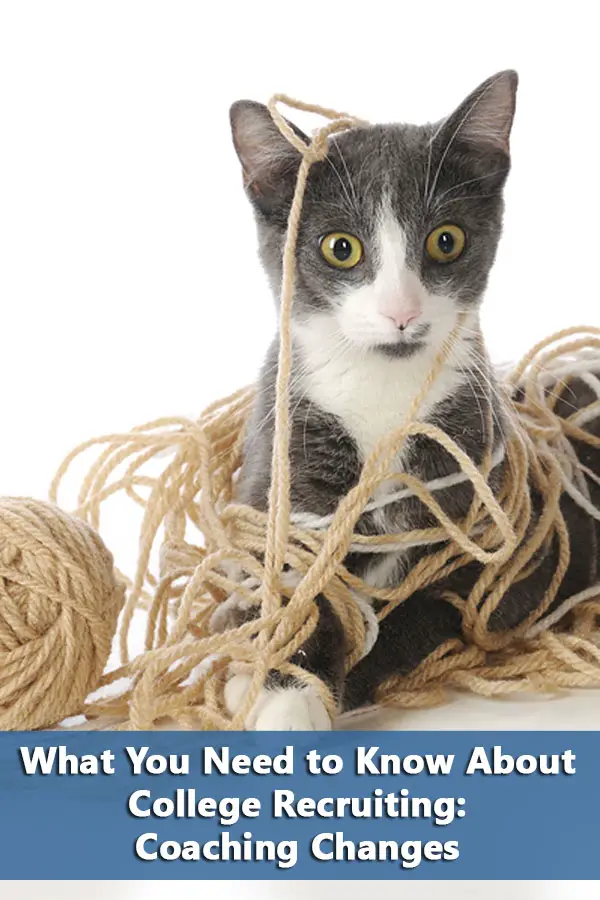 If you have even the slightest interest in college athletics, I don’t think it’s possible to have missed all the press on the college football post-season coaching changes. As coaches leave one school for another, there is the question about what happens to the players he recruited. And if you’re an existing, or hopefully soon to be, athletic recruit, the chances of finding yourself dealing with college coaching changes is more likely than you think. So keep up with the reading.
If you have even the slightest interest in college athletics, I don’t think it’s possible to have missed all the press on the college football post-season coaching changes. As coaches leave one school for another, there is the question about what happens to the players he recruited. And if you’re an existing, or hopefully soon to be, athletic recruit, the chances of finding yourself dealing with college coaching changes is more likely than you think. So keep up with the reading.
Time for escape clause for recruits?
An article covering some of the more prominent college football coaching changes at the end of the season and what happened to the recruits. In the case of Mike Weber:
The night before Weber signed with the Buckeyes, Drayton was on the phone with him, persuading him to stick with OSU. The day after Weber signed, the Buckeyes announced Drayton was leaving for the Bears.
The article ends with Roquan Smith who was highly enough rated that he could afford to not sign the NLI. This allowed him to stay in control of his options when the coach left for the NFL. Unfortunately, most players aren’t in his position.
The NCAA’s never going to fix this rule schools can use against recruits
A pretty straight forward analysis of why the NCAA isn’t going to provide players with any sort of escape clause for recruits.
If the NCAA fixes this problem, it would be acknowledging that many recruits choose schools based on coaches, not just the schools themselves. This would not only place more scrutiny on the NIL program, it would also severely hurt the NCAA’s court arguments that athletes choose schools primarily because of education.
Is my athletic scholarship still on the table if there is a coaching change? Does it matter if the coach gets fired or takes a different job?
Depressing answer from Recruiting-101: it all depends. A new coach can come in and keep the recruited players or could make them start the recruiting process all over. This would seem to be an argument in favor of the NLI. However, given that commitments are made months, even years before a player is even eligible to sign the NLI, it’s not really much of an argument.
Recruiting free-for-all gets messier in a coaching change
Another example for football because football, of course, is the only sport worth talking about. Sorry. Anyway, not just about college coaching changes but commitments before anyone signs the NLI. Also presents some interesting numbers on how many scholarships are offered for how many positions. Starts with the following:
When Texas high school running back Daniel Gresham announced Sunday that the University of Louisville’s new coaching staff had revoked his scholarship offer, the news was unsettling, but maybe not all that unusual.
Franklin not stealing players; they’re playing for man who recruited them
Specifically on Penn States’ Franklin and football. Gregg Doyel emphasizes that the only ones who really believe that players who sign the NLI “… have to learn the meaning of the word commitment” are the fans, you know, the ones who believe in the “fairy tale of college sports.” If nothing else, another argument for not signing the NLI.
Coaching carousel impacts recruits
No real analysis or conclusions in this article. It’s worth reading just as a reminder that college coaching changes happen in sports other than football. Reading the article does leave you with the sense that the players really don’t hold any of the cards despite the optimism expressed by some of the players.
Protect Yourself From College Coaching Changes
Advice on how to deal with college coaching changes. Provides some information on how often coaching changes happen using volleyball as an example. It states the obvious that your decision shouldn’t be based only on who is coaching. However, after reading the previous articles, the statement that “If you choose a school for more than just a coach, a coaching change won’t have as big of an impact on your collegiate experience” does seem to be based more on wishful thinking rather than actual experience.
Committed to a Coach, but Signed to a School
Jay Bilas proposes a reasonable solution to coaching changes based on the reality that “Players don’t commit to institutions, they commit to coaches.” He’s for releasing students from the NLI if they haven’t yet matriculated. And his suggestion for changing the transfer rule seems reasonable: “I feel recruits should be subject to the current transfer rule, but should still have five years to complete four years of eligibility after sitting out a season.” Of course, the coach is getting still getting paid during this period but the players will have to come up with tuition on their own.


